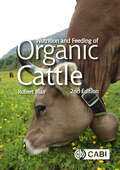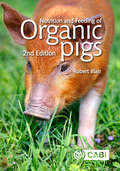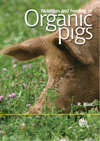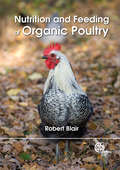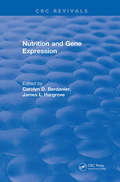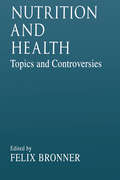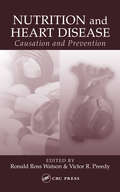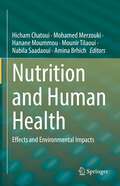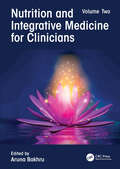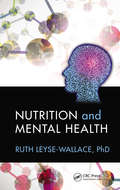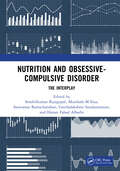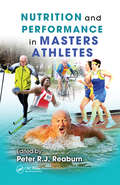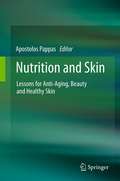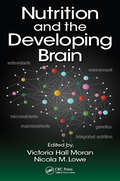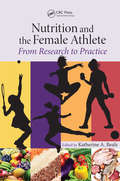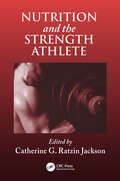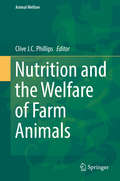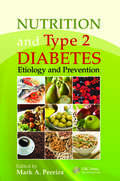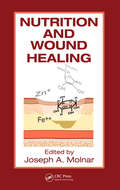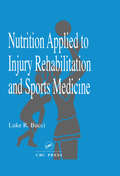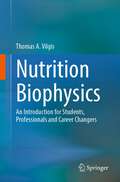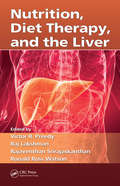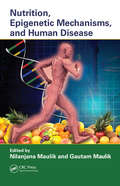- Table View
- List View
Nutrition and Feeding of Organic Cattle
by Robert BlairOrganic cattle farming is on the increase, with consumer demand for organic milk and meat growing yearly. Beginning with an overview of the aims and principles behind organic cattle production, this book presents extensive information about how to feed cattle so that the milk and meat produced meet organic standards, and provides a comprehensive summary of ruminant digestive processes and nutrition. Since the publication of the first edition, global consumers have increasingly become concerned with the sustainability of meat production. Here, Robert Blair considers the interrelationships of sustainable practices and profitability of organic herds, reviewing how to improve forage production and quality, and minimizing the need for supplementary feeding using off-farm ingredients. This new edition also covers: - Managing a recurrent shortage of organic feed ingredients, due to increased GM feed crop cultivation worldwide - Current findings on appropriate breeds and grazing systems for forage-based organic production - Diet-related health issues in organic herds and the effects of organic production on meat and milk quality. Required reading for animal science researchers, advisory personnel that service the organic milk and beef industries and students interested in organic milk and meat production, this book is also a useful resource for organic farming associations, veterinarians, and feed and food industry personnel.
Nutrition and Feeding of Organic Pigs
by Robert BlairOrganic animal production has increased rapidly in recent years to keep up with the increasing consumer demand for organic meats. There are many guidelines and restrictions on what should go into the feedstuffs of organically farmed animals, from which difficulties arise when trying to ensure a well-balanced, nutritious diet without the use of any supplements. This second edition of Robert Blair's classic and bestselling book on the nutrition and feeding of organic pigs presents comprehensive advice that includes: - formulating appropriate diets and integrating them into organic pig production systems; - international standards of organic feeding; - feed-related disease incidence in organic herds. The book has been completely updated and revised to address how to formulate organic diets in situations where there is a declining supply of organic feed, as well as the feasibility of utilizing novel feedstuffs and their acceptability by consumers of organic meat products. Including the experiences of producers in relation to appropriate breeds and production systems for forage-based organic production, this book is an important read for researchers and students of organic food animal production, veterinary sciences and food; as well as food industry personnel and organic farmers.
Nutrition and Feeding of Organic Pigs
by Robert BlairOrganic animal production has increased rapidly in recent years to keep up with the increasing consumer demand for organic meats. There are many guidelines and restrictions on what should go into the feedstuffs of organically farmed animals, from which difficulties arise when trying to ensure a well-balanced, nutritious diet without the use of any supplements. This second edition of Robert Blair's classic and bestselling book on the nutrition and feeding of organic pigs presents comprehensive advice that includes: - formulating appropriate diets and integrating them into organic pig production systems; - international standards of organic feeding; - feed-related disease incidence in organic herds. The book has been completely updated and revised to address how to formulate organic diets in situations where there is a declining supply of organic feed, as well as the feasibility of utilizing novel feedstuffs and their acceptability by consumers of organic meat products. Including the experiences of producers in relation to appropriate breeds and production systems for forage-based organic production, this book is an important read for researchers and students of organic food animal production, veterinary sciences and food; as well as food industry personnel and organic farmers.
Nutrition and Feeding of Organic Pigs
by Robert BlairA comprehensive text on feeding organic pigs, this book presents advice on formulating appropriate diets and integrating them into organic pig production systems. It outlines the international standards of organic feeding, the breeds of pig that are most suitable for organic farming, up to date information on the nutritional requirements of pigs, and examples of diets formulated to organic standards.
Nutrition and Feeding of Organic Poultry
by Robert BlairOrganic poultry production has increased significantly in recent years in response to increasing consumer demand for organic eggs and meat. Nutrition and Feeding of Organic Poultry is the first comprehensive text on feeding organic poultry, presenting advice on selecting suitable ingredients, preparing appropriate feed mixtures and integrating them into organic poultry production systems. The international standards of organic feeding, the species and breeds of poultry most suitable for organic farming, up-to-date information on the nutritional requirements of poultry and examples of diets formulated to organic standards are all discussed.
Nutrition and Gene Expression
by Carolyn D. BerdanierNutrition and Gene Expression is devoted to exploring the tissue-specific and developmental aspects of the interaction between nutrients and the genome. The book discusses chemical sensitivity in relation to the ability of cells to detect nutrients; reviews the means by which lower organisms respond to nutrients; and provides examples on how each of the classes of nutrients affects genetic transcription, mRNA translation or stability. The receptor-mediated actions of vitamin D and retinoic acid on gene expression are discussed, including the case of bone formation and dissolution. Other important topics covered in the volume include newly discovered effects of fatty acids on regulating gene expression, the effects of diet on mRNA editing, the interplay between dietary carbohydrates and proteins in regulating metabolism of liver cells, the effects of metal ions on protein synthesis, and much more. Nutrition and Gene Expression is an important reference for nutritionists, physiologists, biochemists, clinical nutritionists, pharmaceutical researchers, geneticists, and food scientists.
Nutrition and HealthTopics and Controversies
by Felix BronnerNutrition and Health: Topics and Controversies explores in detail the relationship between diet, nutritional status, and disease, and evaluates nutritional practices intended to minimize the incidence of and slow the progress of major chronic illnesses. National trends in nutritional awareness and the resulting changes in consumer behavior are discussed. Unlike other books on this subject, the authors take a stand on controversial issues in the field and document their positions with scientific data. Nutrients such as calcium, vitamin E, selenium, and antioxidants, their importance in overall nutrition, and their role in specific diseases are covered. Expertise in nutritional science is not required to gain the highly practical information in this book.
Nutrition and Heart Disease: Causation and Prevention
by Ronald Ross Watson Victor R. PreedyHeart disease is the primary cause of death and disability in Western countries. Research indicates that nutrition and diet play key roles in both preventing and causing many types of heart damage and dysfunction. By understanding the complex relationship between diet and disease, new prevention measures can be established and millions of lives can
Nutrition and Human Health: Effects and Environmental Impacts
by Hicham Chatoui Mohamed Merzouki Hanane Moummou Mounir Tilaoui Nabila Saadaoui Amina BrhichThis book brings together innovative research that examines respectively climate change, agricultural production, environmental impacts, food security, nutrition and human health issues with regard to international policies as well as sustainable development goals. As sustainability continues to be a high concern in the scholarly community, food security has become a critical worldwide topic. Food supplies are challenged by factors such as toxicity, substandard food processes, difficulties in providing food to struggling populations and changes to the environment due to climate change egislation can protect public health, but law-makers must understand the current complications facing food security today. This book features a broad range of topics including ecotoxicology, smart food, and wastewater reuse impacts. The book aims to look at how we can protect and improve the health of vulnerable populations as well as innovative solutions to food insecurity. It is ideally designed for university students, from undergraduate to Ph.D. level, professors, researchers, professionals, environmentalists, physio-pathologists, medical doctors, epidemiologists, policies makers and sociologists.
Nutrition and Integrative Medicine for Clinicians: Volume Two
by Aruna BakhruMystery illness can be helped, and this book lays the groundwork for it! Can a water-damaged building ruin your health and cause debilitating exhaustion, chronic pain, insomnia, anxiety, obesity and "brain fog?" Could a flood or wet basement make you sick even if it has long dried out? Building on its predecessor, Nutrition and Integrative Medicine for Clinicians: Volume Two is an essential, peer-reviewed resource for practitioners to help patients with various illnesses found in society, including those contracted from water-damaged structures, that can lay the groundwork for a healthy road to recovery. Written by authors at the forefront of their respective fields, this book presents information for people "written off" as having a "mystery illness," fibromyalgia or chronic fatigue. Chronic inflammatory response syndrome (CIRS) is ubiquitous and affects many body systems, yet it is largely unrecognized by doctors, who misdiagnose CIRS patients daily. This book is a comprehensive guide on evaluating illnesses that are difficult to diagnose, including CIRS. This volume contains information on various subjects, including: Illnesses resulting from water-damaged buildings and subsequent change in the microbiome of the building. Steps to heal from mold/mycotoxin illnesses. Legal and ethical considerations in health issues from exposure to a water-damaged building as well as introducing the "building science" to clinicians. Effects of CIRS on metabolism and insulin resistance. Environmental hormone disruptors. Myalgic encephalitis/chronic fatigue syndrome. Regenerative agriculture. Pediatric sleep-related breathing disorders and their effects on growth and development. Circadian effects of artificial light and their effects on mitochondria. Nutritional support in Covid. The design nature of sound and its relationship to neural networks. The human body as a biological sound healing instrument. The use of color in clinical application. Art in medicine. Living life with intentionality and mindfulness. Making childbirth a positive experience.
Nutrition and Mental Health
by Ruth Leyse-WallaceAn examination of the role nutrients play in mental health, this book reviews the scientific literature from many fields of science: health, psychology, nutrition, mental well-being, and the interface with chronic disease. The book provides a straightforward, readable report of broadly selected scientific research on how various nutrients affect mental health. It covers several types of mental health disorders and their links to nutrients, nutritional status, and nutritional supplements. This book provides mental health professionals with the information they need to evaluate nutritional issues.
Nutrition and Obsessive-Compulsive Disorder: The Interplay
by Senthilkumar Rajagopal Saravanan Ramachandran Geethalakshmi Sundararaman Hanan Fahad Alharbi Musthafa M EssaKey features – Covers emerging therapeutic and nutritional approaches for the treatment and management of OCD Reviews the role of various micro-nutrients in OCD Discusses the prenatal genetic diagnosis and application of computational modelling in OCD Includes the nutritional and dietary roles in neuropsychiatric disorders like depression and obsessive-compulsive disorder (OCD) Explores the application of nano-biotechnology in OCD
Nutrition and Performance in Masters Athletes
by Peter R.J. ReaburnAddresses the Aging Process and Its Effect on Sports PerformanceAge-related changes influence all physiological systems, including those used during exercise and sport. Highlighting masters athletes-older adults who train and compete in organized sports-Nutrition and Performance in Masters Athletes examines the extent to which regular physical trai
Nutrition and Skin
by Apostolos PappasThe book will educate and decode the role of vitamins, essential fatty acids and other nutraceuticals on skin health and their tremendous impact to the current needs of the skin care industry. Focus on conditions, as acne, dermatitis, dry scaly skin or alopecia will provide a comprehensive knowledge of the relationship of nutrition and skin as well as the current attempts in nutritional or dermatological research. It will stimulate food professionals to brainstorm for new products and opportunities that will target the emerging antiaging and wellness trends and modern consumer needs.
Nutrition and the Developing Brain
by Victoria Hall Moran Nicola M. LoweNutrients play a significant role in brain development throughout fetal and postnatal life. This book reviews the evidence from animal and human research, highlighting the influence of specific nutrients on brain function and cognitive development. With a unique, integrative approach to the nutritional, environmental, and genetic influences on brain development, the book examines issues such as single versus multiple limiting nutrients, critical periods of deficiency, and the impact of the child-parent relationship on the architecture of the developing brain. <P><P>The effect of undernutrition on the developing brain of infants and young children can be devastating and enduring. It can impede behavioural and cognitive development and educability, thereby undermining future work productivity. Chapter authors are experts in this field of research and provide an up-to-date insight into the role of the individual nutrients in brain development and function.
Nutrition and the Female Athlete: From Research to Practice
by Katherine A. BealsDesigned to address the nutritional needs of women over the age of 18 who partake in sports on a regular basis, Nutrition and the Female Athlete: From Research to Practice highlights nutritional concerns specific to active women. It discusses the link between nutrition and athletic performance and translates research into practical applications for
Nutrition and the Strength Athlete
by Catherine G. R. JacksonBoth strength training and weight training are recognized by the American College of Sports Medicine as vital to a high quality of life. They are also of tremendous benefit to young, healthy adults and adults with or at risk for osteoporosis. Most information on nutrition and strength athletes, however, is scattered throughout pamphlet-type publica
Nutrition and the Welfare of Farm Animals
by Clive J. C. PhillipsThis book explores the importance of good nutrition in ensuring an adequate standard of welfare for farm animals. It is often not realized that farm animals can suffer when they are fed unsuitable diets, which may be because these diets are more economic or the farmer does not know how to rectify poor nutrition. This book reveals how to recognize and deal with feeding problems in farm animals, when the animal's behaviour is indicating a deficiency, through oral stereotypies for example. Feeding livestock in emergency situations can present special challenges, and the availability of clean and potable water, one of the essential components of life, can also be an unrecognized problem for many farm animals. Feeding farm animals effectively is rarely recognized for the major welfare issue that it is. We may assume that animals in intensive husbandry conditions have adequate feed, yet it is often too concentrated and designed primarily to immediately maximize production from the animals, in the form of growth, milk yield or reproduction. In extensive rangeland conditions adequate feed supply also cannot be assured, potentially leading to undernutrition with serious consequences for the health and even survival of livestock. This book will provide a much-needed review of the relationships between nutrition and the welfare of farm animals.
Nutrition and Type 2 Diabetes: Etiology and Prevention
by Mark A. PereiraOver the past two decades, type 2 diabetes has emerged as a leading threat to global health, and the considerable overlap in obesity and diabetes trends are likely no coincidence. Focusing on the worldwide impact of type 2 diabetes regarding nutrition, dietary modification, and risk, this book draws on evidence-based research, providing a comprehensive description and evaluation of the central findings to date, primarily in humans. Topics include the role of macronutrients and their subclasses, micronutrients, foods, beverages, and overall dietary patterns with respect to the risk of type 2 diabetes. Chapters discuss fundamental nutritional principles applied to the pathophysiology of the disease as well as applied behavioral studies on nutrition and diabetes.
Nutrition and Wound Healing (Modern Nutrition Science)
by Joseph MolnarWith mounting evidence regarding the role of poor nutrition in the development of chronic diseases such as heart disease and diabetes, it is no secret that appropriate nutrition is crucial to optimal health. Achieving the correct balance of elements provides the body with the ability to adapt to a shifting and often hazardous environment. Never is
Nutrition Applied to Injury Rehabilitation and Sports Medicine (Nutrition In Exercise And Sport Ser. #4)
by Luke R. BucciThis timely and exciting new book brings together for the first time the readily available choices of dietary supplements and their relationship to injury rehabilitation. Nutrition Applied to Injury Rehabilitation and Sports Medicine supports the rational use of specific nutrients for specific healing conditions. Guidelines for nutritional programs applied to specific conditions are provided for practical application.
Nutrition Biophysics: An Introduction for Students, Professionals and Career Changers
by Thomas A. VilgisDo you no longer understand the countless, contradictory dietary recommendations? Do you find it difficult to distinguish between good and bad when it comes to cholesterol? Are you torn between the various dietary rules and nutritional forms that come your way every day and despair of the term "healthy diet"? Or are you confronted professionally, e.g. as a consultant or fitness coach, with questions on the subject of nutrition and would like to learn the scientific basics? The author Thomas Vilgis advises you to remain calm and to think objectively about all assumptions, presumptions, promises and suggestions for orientation.This book leads you off the beaten track and with a scientific, sober view to fundamental questions of nutrition. Starting with the nutritional history of Homo sapiens, the author guides you into the fundamental interplay between proteins, fats, and carbohydrates, what they do in the body, how they are digested, and what role they really play. Supporting you will find in the second edition various retrievable videos in which complex relationships are clearly explained. This quickly shows how little is hidden behind some dubious statements. With the claim of a scientific and molecular view of nutrition, it is possible to put into perspective and classify many a questionable recommendation on nutrition in an understandable and entertaining way.
Nutrition, Chemistry, and Health Effects of Sugar, Salt, and Milkfat (SpringerBriefs in Molecular Science)
by Salvatore ParisiThis book covers sugar, salt and milk fat from a chemical perspective, and presents an overview of the role of these ingredients in our food, focusing on their flavors, satiety-inducing properties, nutritional impact, and health effects. The book begins with a chapter devoted to the chemical composition of these taste enhancers and satiety-inducing components, followed by a chapter that sheds light on the persuasive tactics employed by the food industry and their impact on consumer behavior, ultimately discussing the complex relationship between marketing strategies and public health. In Chapter 3, the author presents case studies and explores the nutritional requirements of these ingredients, while considering their physiological effects ad potential implications for human health. In Chapter 4, the author evaluates current consumption patterns and their implications, analyzing trends, policies, and opportunities to shape healthier dietary choices. The book closes with a chapter devoted to the effects of glucose, sodium and cholesterol deficiency, where the author discusses the consequences of imbalanced intake or deficiencies in these ingredients and outlines their impact on human health as well as evidence-based recommendations for keeping a balanced diet. Researchers, scholars, and students in the fields of food science, nutrition, chemistry will understand the appeal of this book.
Nutrition, Diet Therapy, and the Liver
by Victor R. Preedy Raj Lakshman Rajaventhan Srirajaskanthan Ronald Ross WatsonWell-illustrated throughout and with in-depth analyses, Nutrition, Diet Therapy, and the Liver provides a holistic understanding of the causative elements that precipitate liver disease and the nutritional factors and regimens that reverse deteriorating hepatic function. This up-to-date resource also incorporates emerging fields of science and sign
Nutrition, Epigenetic Mechanisms, and Human Disease
by Nilanjana Maulik Gautam MaulikAs nutrition research is shifting its focus from epidemiology and physiology to effects of nutrients at the molecular level, a uniquely tailored diet that corresponds to the demands of our genetic signature is emerging as an indispensable need. Using high-throughput genomic tools, nutrigenomics unravels the influence of micro- and macronutrients as
